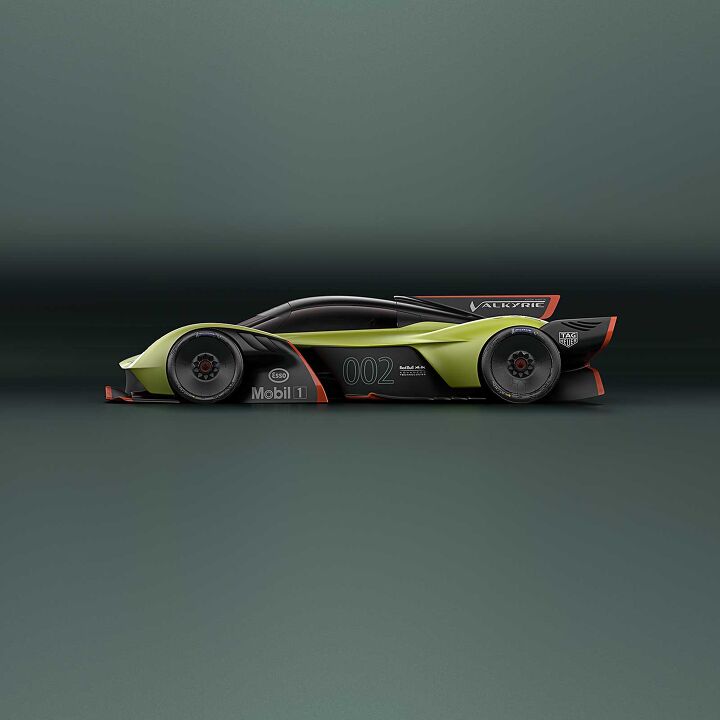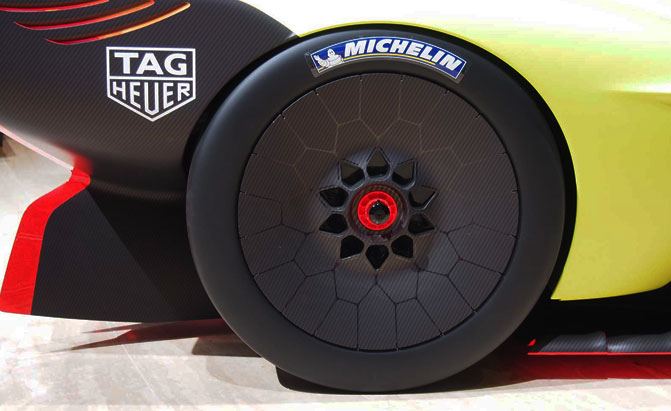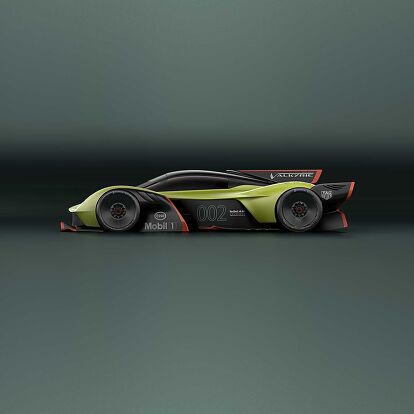7 Facts About the Aston Martin Valkyrie You Might Not Have Heard Yet


The upcoming Aston Martin Valkyrie is a hypercar in every sense. Co-developed with the speed freaks at Red Bull Advanced Technologies, it will bring Formula One hardware to the street when it arrives, likely late next year.
The British automaker is deep in development of this roadgoing rocket, which is why many important details about it have not been released; they simply aren’t finalized at this point. But keeping the press and public alike buzzing with excitement about its eventual debut, Aston Martin unveiled their Valkyrie AMR Pro at the Geneva Motor Show.
An even more extreme, track-only version of the car, it promises to bend the very laws of physics in pursuit of absolute performance. “It’s going to be quite extraordinary,” admitted Dave King during a one-on-one interview with AutoGuide.com. Deeply involved in this vehicle’s creation, he’s vice president of special projects and the president of Aston Martin Racing.
SEE ALSO: Complete 2018 Geneva Motor Show Coverage
A quick glance at the data released about Valkyrie AMR Pro instantly validates King’s comment. With a hybrid drivetrain on board, it will be graced with more than 1,100 brake horsepower. A carbon fiber body and structure keep mass in check, which should clock in around 2,205 pounds (1,000 kilograms). Terminal velocity is expected to be 224 miles an hour (360 km/h). And if those figures weren’t impressive enough, the car will also be able to scramble your internal organs by providing more than 3 G’s of lateral acceleration.
But these are just the figures Aston Martin has released publicly. We were able to wrest a few more nuggets of information about the roadgoing Valkyrie and its AMR Pro variant out of King during an extended chat in Geneva.
7. Electric Reverse

One of the most interesting details he revealed about this car is that it will back up under electrical power. “The whole thing about not having a mechanical reverse is… to keep the gearbox as small as possible,” said King. “The motor’s there anyway, so, why not use it to do reverse to change direction?” This brilliant bit of engineering eliminates a number of hefty components, like gears and bearings.
Enabling this change is a P2 motor mounted between the engine and transmission, a critical part of the energy recovery system. Naturally, it provides the Valkyrie with some other important hybrid vehicle benefits aside from reverse. King explained, “We’re using the electric assist to help with the pull away,” something that’s particularly important on the roadgoing model. “The thing that hurts clutches is slip, so we don’t want a clutch that needs to slip really, so, [we] use the electric motor to start the pull-away process to get a very quick clutch engagement.” He also added that this motor helps the Valkyrie’s single-clutch automatic transmission during gear-changes.
SEE ALSO: 2018 Aston Martin DB11 Volante Review
When asked to share additional details about the transmission King said, “No, I’ve told you too much already.” With a smile, he also noted, “Electric reverse gear, you’ve heard it here first.”
6. It’ll Spin North of 10,000 RPM

The heart and soul of Valkyrie’s powertrain is a 6.5-liter V12. Aside from displacement, cylinder count and configuration as well as its colossal horsepower figure, nothing else has really been released about this engine.
But to deliver some 1,100 ponies without the help of a turbo or supercharger means this thing has to rev, and not just to the stratosphere but beyond our solar system. Even though King said, “We’re not talking about the redline at the moment,” he acknowledged the Valkyrie will spin “well over 10,000 rpm.”
Obviously, building an all-out racing powerplant has plenty challenges, but in the case of Valkyrie, they may not be what you’d expect. “It’s not so much [trouble] making a high-revving engine if you use the right materials, design it properly,” said King. “That’s fine, but then being able to get drivability at low speed, pull away, town driving and emissions capability at two-or-three-thousand rpm when it’s all tuned for max power at 10,000-plus, that’s a challenge.” Remember, the AMR Pro may be for track only, but the standard Valkyrie is still intended for use on public streets, meaning it must comply with safety, emissions, fuel economy and other regulations around the world.
To bolster everyday drivability, King said this V12 has some trick stuff designed to create turbulence and increase the incoming air’s velocity at low speeds to promote decent-quality combustion, but he wouldn’t go into specifics. Perhaps it’s equipped with adjustable restrictors in the intake runners or maybe some of the intake valves are deactivated at light loads.
5. More Power, Shorter Life

Compared to the standard Valkyrie, AMR Pro versions will have more power, with plenty of extra to be had in the exhaust system. Since the track-only model needn’t meet emissions standards, King said engineers were able to ditch the catalytic converters, majorly reduce backpressure and then recalibrate for even more giddy-up.
Beyond that, the engine is expected to be torn down at regular intervals, something that allows them to run higher cylinder pressures, put a bit more stress on the mechanical components. King noted, “[That’s] because you know it’s going to get a 20,000-kilometer rebuild. I’m not saying that’s the service interval – that’s not the rebuild interval – but it’s not like designing it for 100,000-kilometer life.”
4. A Thousand Hours
Like a racing machine, the Valkyrie is built around a carbon fiber tub, one that rivals what’s employed in modern Formula One cars. “You’re reinforcing where the load inputs are to the tub, everywhere you don’t need material you’ve got as little as possible,” said King. “The whole thing is going to take the best part of a thousand hours of layup.”
Yes, you read that correctly. He said it takes technicians around 1,000 hours to create the Valkyrie’s passenger cell. The process is totally manual, which is why it takes so long.
3. Major Machining
And it’s not just this Aston Martin’s underlying structure that receives lavish amounts of time and attention. Every detail has been scrutinized in order to trim as much weight as possible.
Take the metal inserts that are bolted to the carbon fiber tub. They’re made of aerospace-grade titanium and machined down to the absolute minimum to meet the load requirements. “I think we, from the titanium billet that we start with… we’re turning 95 percent of it to swarf to get the 5 percent yield on the remaining [part],” King explained. That waste “gets reused, of course, but [it’s] a lot of machining time.”
2. “Many Tens of Kilos”
Attention to detail like this helps keep this car’s mass in check. The AMR Pro’s featherlight curb weight of around 1,000 kilograms should be appreciably less than the standard Valkyrie’s.
“We’re not saying exactly how much the road car weighs,” noted King, but, “We’re taking many tens of kilos out of the road car to get to the AMR Pro. Many tens of kilos.”
SEE ALSO: 2018 Aston Martin DB11 V12 Review
Some of the major changes that result in that weight loss include the lack of an emission system. Beyond that, the suspension is made from carbon fiber instead of aluminum, the bodywork is a bit thinner, they’ve used plastic for the windows instead of glass and the interior lacks climate control and audio systems.
1. No, You Can’t Have One

As for production, Aston Martin will build 150 road-going Valkyries, but just 25 copies of the AMR Pro are destined for production. “We don’t talk specifically about those sort of details, but we’ve got demand far exceeding availability,” said King. A happy problem for the company.
Development of the street-legal version is priority, but the track car is well underway. No specific delivery date has been shared for either model, but King explained the first prototypes are expected to be ready for testing this summer. Production cars should arrive in the second-half of next year, with the first deliveries to customers taking place in late 2019.
For now, this is just a glimpse at what the Aston Martin Valkyrie will offer. More details will be released closer to launch. “There’s plenty of mind-bending stuff,” said King.
Discuss this story on our Luxury-Lifestyle Forum

Born and raised in metro Detroit, Craig was steeped in mechanics from childhood. He feels as much at home with a wrench or welding gun in his hand as he does behind the wheel or in front of a camera. Putting his Bachelor's Degree in Journalism to good use, he's always pumping out videos, reviews, and features for AutoGuide.com. When the workday is over, he can be found out driving his fully restored 1936 Ford V8 sedan. Craig has covered the automotive industry full time for more than 10 years and is a member of the Automotive Press Association (APA) and Midwest Automotive Media Association (MAMA).
More by Craig Cole











































Comments
Join the conversation
What city has streets good enough for this to drive on? Hitting one decent pothole would just ruin your day.